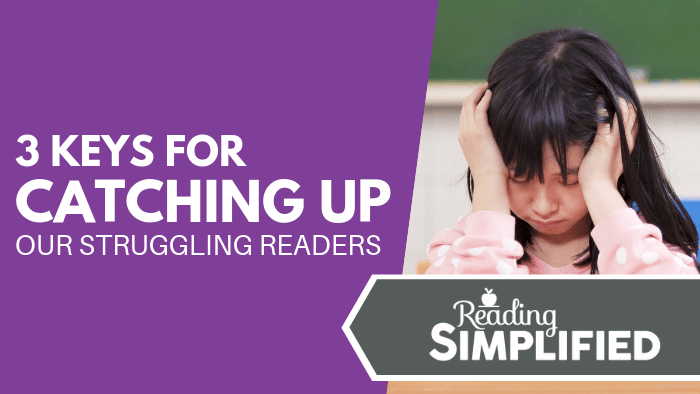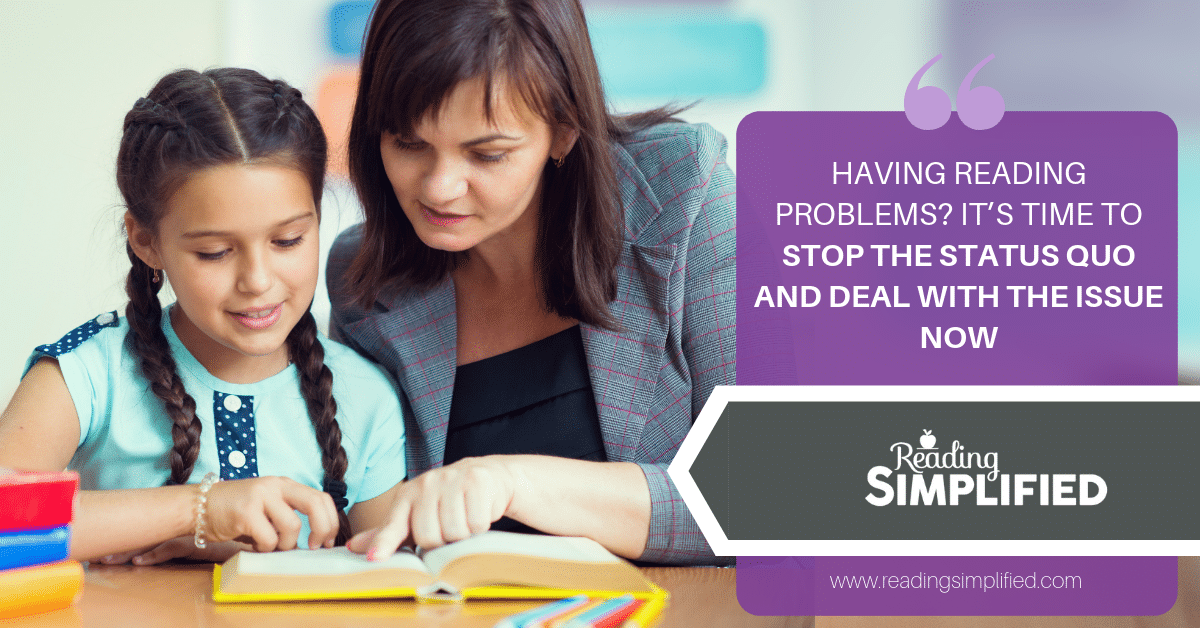
Do you have a few struggling readers that have fallen behind the rest of the class?
You may have a class of 20 great readers, but perhaps a few of them aren’t quite at the same level as the rest of the other students. The underlying source of their problem is likely that they have a poor sound-based decoding foundation.
What can you do to help kids who aren’t meeting the benchmark?
In this post, I share three keys for getting those struggling readers back up to grade level or above!
(To watch the video where I discuss the tips in more detail, hit play below, or read on for a detailed overview)
1. Change the Status Quo
My first tip is to abandon the status quo. We can't stick band-aids on a problem of this magnitude and expect real results, right?
Say you have students in fifth grade, and yet they’re reading at a second-grade level. Stop the bus. 😉 Do not pass go, etc., until you prioritize getting their reading back up to grade level.
It should be the number 1 priority for everyone in the school to solve that problem----now.

However, a mistake that many teachers and schools make when they face a challenge like this is to stick to the same old status quo. But the day-to-day curriculum hasn't worked yet, so it's not likely ever going to work!
You can’t keep doing the same thing and expect different results, right? And, if the existing status quo has failed you so far, why would it suddenly change now?
The school team should stop everything else (so to speak) and make reading priority number one. If students are struggling with reading, it’s safe to assume that they’re going to face challenges in other areas of their studies too. If they can’t learn English, they can’t tackle things like social studies, science, history or even math!
So, how can you change the status quo in a way that’s actually going to help struggling readers catch up?
Don't expect that 20 minutes a few times a week from a scripted program hosted by an under-prepared teacher will resolve this.
Rather, an intense and extensive reading intervention from a highly-trained reading specialist is vital.
Let's talk more about what's meant by "intense" reading intervention...
2. Provide intensive reading interventions
Reading interventions that increase in intensity and duration over a period of weeks can be hugely beneficial for struggling readers.
Research has shown that kids who have had reading interventions are more likely to move from, for example, the second percentile to the average range with just 70 hours of instruction time.
Seventy hours may seem drastic, right?
That's really what I'm calling for...a drastic turn from the status quo so fewer and fewer students suffer from unnecessary reading difficulties.
Some good news: if you use the strategies and activities we teach here at Reading Simplified, you’ll likely be able to reach the same results at a much quicker pace.
For instance, in my clinical practice, I typically see students get to grade level in sound-based decoding after just 12 hours of evidence-based instruction. In some cases, a struggling reader will require three to four times as much instruction as a typically developing student.
But whether it takes 12 hours or 70, the focus needs to be intense for a season until the problem is resolved.
3. Research-based Interventions
If a student can’t read at grade level, whether they’re in fifth, seventh or ninth grade, the root of the problem is almost always because they can’t decode well. They aren’t fluent and don’t recognize words fast enough. As a result, comprehension breaks down.
What happens if a student has poor sound-based decoding?
It’s simple. We need to shore up that foundation! You can do this by picking an intervention where the activities are based on a strong-research. You want to use a tried-and-tested approach that actively builds on shoring up the sound-based decoding foundation.
You can take a look at this pyramid diagram below, which is a visual representation that shows sound-based decoding is the foundation of being a good reader. When the sound-based decoding is good, it directly affects the other levels of the pyramid, i.e. word identification, fluency, and comprehension.
Once a kid has a strong sound based decoding foundation, they start to memorize words more readily and more accurately. Then they become fluent. And when they’re fluent, they can comprehend a lot more easily. Voilá!
Reading Simplified rapidly shores up this sound-based decoding foundation.
And our approach not only is based in essential principles that arise from the reading research literature, it also is a streamlined adaptation of another approach I developed that has yielded good results in multiple studies.
If you want a concise synopsis of some of the evidence that supports Reading Simplified, snag your brief PDF at the bottom of this post.
Join the 3 Activities a Day to Keep Reading Difficulties Away Workshop!
Discover the core activities that solve most sound-based decoding challenges. These three activities are Switch It, Read it and Sort It. I share these three activities with you in our complementary 3 Activities a Day to Keep Reading Difficulties Away workshop.
When you join this workshop, you’ll learn how to save time by integrating multiple reading skills simultaneously, so students better understand their lessons + less planning & instructional time is wasted!





Our school is using PALS data to see which students are reading one to two grade levels below their current grade, and then group the students into Tier 1(on or above grade level), Tier 2(one grade level below their grade), Tier 3(two or more grade levels below their grade). Reading specialists and literacy tutors meet with Tier 3 and lower Tier 2 students in reading intervention groups while classroom teachers service Tier 1 and upper Tier 2 students in small group reading instruction. We have seen some success but need more because we still have 3rd through 5th grade students performing below their grade levels, yet are expected to pass the Virginia Standards of Learning assessment at the end of the school year.
Charlene, it’s great to hear about your school’s tracking and intervention efforts! They sound very wise!
I do find that many typical reading interventions take more than 1 year to catch up most students who are more than 1 year behind. If you can test out some core Reading Simplified strategies, you may find faster growth. The main activities to test are explained here: readingsimplified.com/start-here-2
Thanks for sharing your school’s good work!
Our struggling students are seen by our Readng Intervention Team. Our whole elementary has been using Accelerated Reading program and take the STAR Reading assessment. I have not seen asignificant change in the students. The good readers are still doing well. The poor students are still struggling. I would appreciate your professional thoughts on AR and STAR.
Ruth, AR is a powerful tool for encouraging reading practice but its success depends on its implementation. STAR is also very helpful in getting a quick measure of reading achievement for a whole school, but I believe it doesn’t pinpoint the source of reading problems.
Most reading problems stem from a crack in the foundation. Weak phonological decoding (or sound-based decoding) is almost always the primary cause. I would give all struggling readers a standardized Word Attack test (i.e., a nonsense word test) to determine if that’s an area of need. If you don’t have that test, I link to a free one here.
If Word Attack isn’t strong (I like to see scores that are above grade level), then our core reading activities will solve that problem rapidly. You can learn about the core activities in a complementary on-demand workshop: 3 Activities a Day to Keep Reading Difficulties Away here.
Hope this helps!
I am an educator but would like to help address my own daughter’s gaps in reading. What would I use to get started with her? I’d like a diagnostic assessment so I can begin teaching her where she is at. She is currently in grade 3 (French immersion) and while her reading is about 1 year behind the expectation for French learners, she also is a very poor speller as a result of a lack of phoneme knowledge. Will this program help with both reading and spelling? Also, would you say it is completely aligned with The Science of Reading or no? Please explain further. Thank you! Cheryl
Cheryl, we’d love to help! We have complimentary assessment info here:
https://readingsimplified.com/reading-levels-assessments (but it’s not in French)
Then to learn the basics of our system, you could see the Most Popular blog posts here.
Or, you can go through our paid Reading Simplified Academy for the full system and our support here:
ReadingSimplified.com/academy
Finally, yes, our system is quite well aligned to the most current info about the science of reading. I explain some science basics as I teach practical activities here:
https://readingsimplified.com/science-of-reading
I just finished my teaching degree, and I am working as an instructional interventionist for the rest of the school year. I am working with 3rd and 4th graders, and at times I feel inadequate and overwhelmed. We have some 3rd graders who can barely read….like, 4 words a minute. How in the world do I help students like that? Any advice and resources would be GREATLY appreciated.
One of the first things you can do is find out where the foundational deficits exist. With that information, you can target their most pressing needs to make the most progress, without wasting valuable time on what they already do know.
This post outlines some assessments you can use to determine where the gaps are: https://readingsimplified.com/reading-tests/
This simple activity can help build the foundation for good sound based decoding. https://readingsimplified.com/integrate-dont-isolate/
And this one gives a sneak peak on the other Reading Simplified strategies we employ to meet the varied needs of our students most effectively so they can experience accelerated growth.
https://readingsimplified.com/small-group-guided-reading-structure/
My 5th grader passed her SOLs but takes several hours longer than all her peers to complete them. Her comprehension is ok but her deciding and times independent reading is at grade 3. I know if that doesn’t improve her comprehension will start to flounder as well. The school will not help because she passes SOLs. How can I help her?
Rachel, it’s great that she is passing her SOLs! But I also agree that further help will likely allow her to flourish more.
Are you saying that her decoding is at the 3rd grade level? If so, then the Reading Simplified system will be very helpful for her I believe. You could test out Switch It with this. Or you could watch a workshop about our 3 most important activities. These can give you a sense of some of what we do.
If you want to learn the full Reading Simplified system, please join the Reading Simplified Academy so we can help you on this inside!